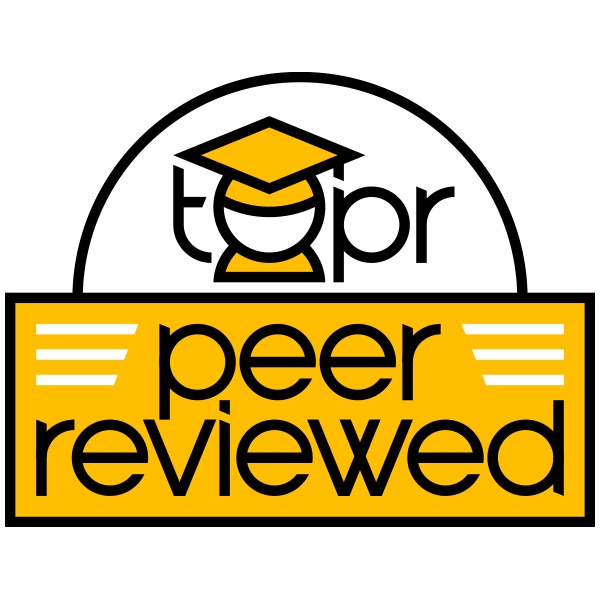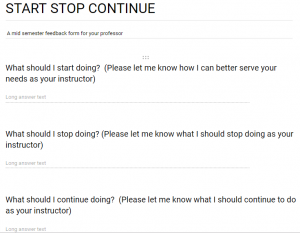
Providing feedback to students in courses is important so they understand how they are performing. However, it is equally important to gather feedback from students. Seldin (1997) stated there are two reasons to gather feedback: “first, to improve teaching performance, and second, to provide a rational and equitable basis for personnel decisions” (p. 335). Feedback is an imperative part of learning, especially if instructor want to improve their teaching practice (Ingvarson & Reid, 2018). Gonzalez (2014), stated seeking feedback from students increases student engagement because the instructor can gather what interests the students have and the type of learning activities they enjoy.
One way of collecting feedback from students can be done using the “Start, Stop and Continue” questions. “A Stop, Start, Continue analysis is a proven approach to collecting valuable feedback” (Swotanalysis.com, 2019). This can be given mid semester in online courses to ask the students three questions:
- What would you like the instructor to start doing?
- What would you like the instructor to stop doing?
- What would you like the instructor to continue doing?
The Start, Stop, and Continue questions can be used in every course and content area. Additionally, the questions can be set up in a discussion board for the instructor to collect feedback or set up in a survey to ensure confidentiality of students and to ensure no names are attached to the responses. The instructor can use the responses to look for patterns and to make changes during the semester to meet the needs of the students when presenting content. The responses can be shared with the students to they know the instructor gathered the feedback and is making the necessary changes.
Link to example artifact(s)
Instructor: Angela Danley
Course: Teacher Education (graduate, online)
I used the Start, Stop, and Continue questions in my online teacher education graduate course. I sent the template through the Google Drive in a survey format (Figure 1) so I could ensure students knew the responses would not have names attached to the responses.

Figure 1. Start Stop Continue in Google Drive.
Submitting this at midterm helped me gather important feedback on how I could tailor my delivery to the students for the remainder of the semester. Student responses included they appreciated the detailed rubrics, additional resources that matched the topics, and course announcements sent throughout the week. Students asked me to continue to what I was doing and were thankful for the feedback. When reviewing the question about start doing, students wanted access to some more videos on the topics. For the question connected to stop doing, students did not provide suggestions, but did ask me to provide any additional relevant resources.
This feedback was beneficial, because I was able to look for video resources on topics for the remainder of the semester. Additionally, this feedback provided me direction in how I planned for my next online graduate course. For example, when planning for a summer graduate course, I included more videos on topics along with setting up a folder for additional resources. Gathering this type of feedback early in the semester helps the instructor meet the needs of the students.
Link to scholarly references
Gonzalez, J. (2014). 5 reasons why you should seek your own student feedback. https://www.cultofpedagogy.com/student-feedback/
Ingvarson, L., & Reid, K. (2018). Improving practice through student feedback. https://www.teachermagazine.com.au/articles/improving-practice-through-student-feedback.
Seldin (1997). Using student feedback to improve teaching. To improve the academy. Retrieved from: http://digitalcommons.unl.edu
Swotanalysis.com (2019). Start, stop, continue how to. https://www.swotanalysis.com/stop-start-continue-how-to-guide
Citation
Danley, A. (2019). Using “start, stop, and continue” to gather student feedback to improve instruction. In A. deNoyelles, A. Albrecht, S. Bauer, & S. Wyatt (Eds.), Teaching Online Pedagogical Repository. Orlando, FL: University of Central Florida Center for Distributed Learning. https://topr.online.ucf.edu/using-start-stop-and-continue-to-gather-student-feedback-to-improve-instruction/.